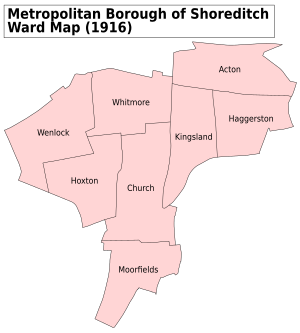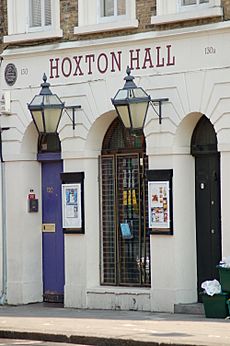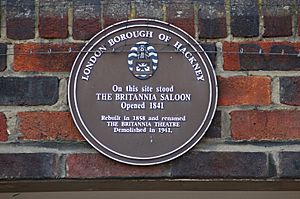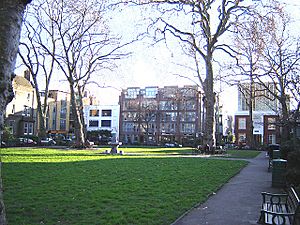Hoxton facts for kids
Quick facts for kids Hoxton |
|
|---|---|
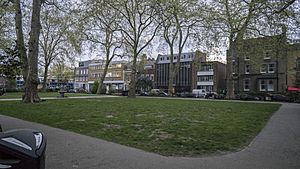 Hoxton Square |
|
| OS grid reference | TQ335835 |
| • Charing Cross | 2.7 mi (4.3 km) SW |
| London borough | |
| Ceremonial county | Greater London |
| Region | |
| Country | England |
| Sovereign state | United Kingdom |
| Post town | LONDON |
| Postcode district | N1 |
| Postcode district | E2 |
| Dialling code | 020 |
| Police | Metropolitan |
| Fire | London |
| Ambulance | London |
| EU Parliament | London |
| UK Parliament |
|
| London Assembly |
|
Hoxton is a cool area in London, England. It's part of the London Borough of Hackney. Many people think of it as part of the East End, which is a historic part of East London.
For a long time, Hoxton was in Middlesex county. It's located just north of the City of London, a major financial district. Hoxton used to be part of the Metropolitan Borough of Shoreditch before it joined the London Borough of Hackney.
Hoxton is generally surrounded by Regent's Canal to the north. Wharf Road and City Road are to the west. Old Street is to the south, and Kingsland Road is to the east.
There's a special area called the Hoxton electoral ward. This ward elects three councillors to the Hackney London Borough Council. Hoxton is also part of the Hackney South and Shoreditch area for Parliament.
Contents
Hoxton's Past: A Journey Through Time
Hoxton's Early Beginnings
The name "Hogesdon" first appeared in the Domesday Book. It meant an old Anglo-Saxon farm or a strong, fenced-in area. Not much is known about how the settlement started. However, the Romans were active nearby. Their road, Ermine Street, ran east of Hoxton from the 1st century.
In medieval times, Hoxton was a countryside area. It was part of the Shoreditch parish. In 1826, Hoxton got its own church, St John the Baptist. This meant it became its own church area.
In 1415, the Lord Mayor of London made a new gate in the city wall. This gate, called Moorgate, helped people walk towards Islington and Hoxton. At that time, these areas were still marshy.
Hoxton in Tudor Times
During the Tudor period, many large houses with moats were built in Hoxton. These houses offered fresh air to ambassadors and royal courtiers. Many Catholics lived here. They were drawn to the house of the Portuguese Ambassador. He held forbidden masses in his private chapel.
One resident was Sir Thomas Tresham. He was put in prison here by Queen Elizabeth I. This was because he was hiding Catholic priests. The open fields north and west of Hoxton were often used for archery practice.
On September 22, 1598, the famous writer Ben Jonson fought a duel in Hoxton Fields. He sadly killed an actor named Gabriel Spencer. Jonson was able to prove he could read and write. This helped him avoid being hanged.
Hoxton's public gardens were a popular spot for people to escape the busy city. It's said that the name of Pimlico came from a pub owner, Ben Pimlico. He was known for his special beer. The gardens were likely near Hoxton Street, which was then called Pimlico Path.
The Gunpowder Plot and a Secret Letter
On October 26, 1605, Hoxton became famous. A letter arrived at the home of Lord Monteagle, a local resident. The letter warned him not to go to Parliament on November 5. It said there would be a "terrible blow" and no one would see who caused it.
This letter might have been sent by his brother-in-law, Francis Tresham. Or, Lord Monteagle might have written it himself to gain favor. The letter was read aloud at dinner. Then, Lord Monteagle gave it to Robert Cecil at Whitehall.
The people planning the plot knew about the letter. But they kept going because their gunpowder was still hidden. Lord Monteagle went with Lord Howard to check Parliament's basement. There, they found Guy Fawkes early on November 5.
Most of the plotters ran away when the Gunpowder Plot was discovered. But Francis Tresham was arrested a few days later at his house in Hoxton. Today, a plaque marks where Lord Monteagle's house was on Hoxton Street.
Hospitals and Homes for Those in Need
By the late 1600s, the large estates of rich families began to be divided. Many of these big houses became schools or hospitals. Some were even used as places for people with mental health conditions. New homes for the poor, called almshouses, were built on the land.
Aske's Almshouses were built on Pitfield Street in 1689. They were funded by Robert Aske. These homes were for 20 poor cloth merchants. There was also a school for 20 children of city members.
Hoxton House opened as a private hospital for mental health in 1695. It grew quickly. The poet Coleridge called it the Hoxton madhouse. People who paid fees could exercise in the large grounds. These grounds were between Pitfield Street and Kingsland Road. The poet Charles Lamb was one of them.
More than 500 poor patients lived in closed wards. It was even the Naval Lunatic Asylum until 1818. The hospital closed in 1911. Today, only a small part of the house remains. It's part of the school that replaced it in 1921, near Hackney Community College.
Around this time, Hoxton Square and Charles Square were created. They became a fashionable area. Different religious groups, called non-conformists, were drawn to Hoxton. They liked being away from the strict rules of the City of London.
Hoxton in the Victorian Era and 20th Century
In the Victorian era, trains made it easier to travel to faraway suburbs. This, along with new buildings and factories, made richer people move away. Hoxton became a place where many poor people lived, and there were many crowded areas. The area became a center for making furniture.
In the 1860s, Hoxton Square became home to the Augustinian Priory. This included the church and school of St Monica. It was built from 1864 to 1866. This was the first Augustinian House in England since the English Reformation.
Charles Booth wrote about Hoxton in 1902. He said: "The whole area is working-class. Poverty is everywhere. Many people have been moved out because of new warehouses and factories. Hoxton is known for its street sellers and furniture trade."
On Hoxton Street, a plaque shows where the Britannia Theatre once stood. This theater grew from old tea gardens and a pub. It became a huge theater with 3,000 seats. It was destroyed during World War II bombing.
Hoxton Hall, also on Hoxton Street, is still a community center today. It started in 1863 as a 'saloon style' music hall. It looks much like it did originally. For many years, it was used as a Quaker meeting house.
The National Centre for Circus Arts is located just north of Hoxton Market. It's in an old electric power station building. Inside, the "Generating Chamber" and "Combustion Chamber" are used for circus training. The building was built in 1895 to burn local trash and make electricity. It also provided steam to heat public baths.
Gainsborough Studios were in an old power station on Poole Street. This was next to the Regent's Canal. Film studios worked here from 1924 to 1951. A historical plaque is on the modern apartment building that stands there now. It mentions famous people like Alfred Hitchcock and films like "The Lady Vanishes".
Hoxton has become very popular and many parts have been improved. This has made some local residents upset. They feel they can no longer afford to live there. However, some parts of Hoxton still have many council housing estates and face challenges.
Hoxton Today: A Creative Hub
The difference between Hoxton and Shoreditch can be confusing. They have a shared history. In the 19th century, they were both part of the Metropolitan Borough of Shoreditch. This area became part of the new London Borough of Hackney in 1965. You can still see old street signs with the name "Shoreditch" around.
After World War II, many small businesses moved out of Hoxton. By the early 1980s, young artists started using these empty industrial buildings as cheap places to live and work. In the early 1990s, art shows, raves, and clubs took over old offices and shops.
Artists like Joshua Compston opened galleries and organized art events in Hoxton Square. Their presence attracted other creative businesses. These included magazines, design companies, and internet companies.
By the end of the 20th century, the southern part of Hoxton was a lively arts and entertainment area. It had many bars, nightclubs, restaurants, and art galleries. People living in Hoxton at this time were known for their unique fashion. This area centers around Hoxton Square. It's a small park surrounded by old industrial buildings. It also has the beautiful 19th-century church of St John's.
The northern part of Hoxton is more residential. It has many council housing estates and new private homes. Residents here are usually older. Unemployment and crime rates are higher in some parts, except for drug offenses, robbery, and theft.
Hoxton Street Market is the main spot in this part of the district. The market sells many household goods during the week. On Saturdays, it focuses on independent fashion, art, and design products. Nearby are the Geffrye Museum and the Hoxton War Memorial.
Property prices have gone up a lot since the early 2000s. This is because developers want to use the area's trendy image. Some art galleries have moved to nearby Shoreditch or other cheaper areas. The local council created a group called The Shoreditch Trust. They buy local buildings and rent them out for community use and housing.
The extension of the East London line (finished in 2010) has brought back local train access. This was lost when the line from Broad Street closed.
Hoxton Market: A Community Hub
Hoxton Market is now on Hoxton Street. It used to be west of Hoxton Square. It started in 1687. This market was very important to the local community. However, from the 1980s, it lost business. People started shopping more at supermarkets instead of traditional street markets.
In 2013, local businesses worked with the Council to bring the market back to life. This effort has attracted a lot of attention and increased trade. New shops have also opened along the market street.
Famous People from Hoxton
Many interesting people have connections to Hoxton:
- Charles Bradlaugh, who started the National Secular Society in 1866, was born here.
- Frank Chapple, a union leader, was born and grew up in Hoxton. He became Lord Chapple of Hoxton in 1985.
- Peter Dean, who played Pete Beale in EastEnders, was born in Hoxton in 1939.
- Jason Donovan, an actor and singer, lived in Hoxton while performing in West End shows.
- Alfred Hitchcock, the famous film director, started his career at the Gainsborough Studios.
- Reggie and Ronnie Kray, well-known East End figures, were born in Hoxton in 1933.
- Marie Lloyd, a music hall star, was born here in 1870. Many of her siblings also became professional performers.
- Jamie Oliver opened his first Fifteen restaurant in Hoxton in 2002.
- James Parkinson, a doctor who researched Parkinson's disease, lived in Hoxton Square.
- Mary Wollstonecraft, a social reformer and writer, was born and spent her early years here. She was the mother of Mary Shelley.
Getting Around Hoxton
 |
Islington | De Beauvoir Town | Dalston |  |
| Clerkenwell | Haggerston | |||
| St Luke's | Old Street | Shoreditch |

- Nearest Stations
Hoxton is a train station on the East London line of the London Overground network. In the southwest of Hoxton, the closest London Underground station is Old Street. This station is on the Northern line. It's also a stop on the National Rail's Northern City Line.
Images for kids
-
Sir Alfred Hitchcock sculpture at the site of Gainsborough Pictures, Poole Street, Hoxton.
See also
 In Spanish: Hoxton para niños
In Spanish: Hoxton para niños



